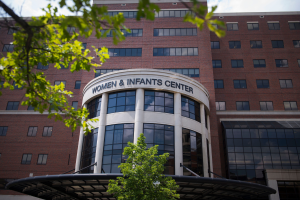For many women, the pursuit of motherhood involves challenges. April is National Infertility Awareness Month, and for several years we have shared stories from women in our community who have faced fertility challenges and about the amazing work UAB Medicine performs to support patients in their fertility journey. Today, we are eager to share more about UAB Medicine and how they are enabling patients to pursue pregnancy in the future through fertility preservation.

To learn more about this topic, we spoke with Dr. Sukhkamal Campbell and Dr. Katia Khoury. Dr. Campbell is a reproductive endocrinology and infertility specialist with UAB’s Women & Infants Services. Dr. Khoury is a clinician-educator in the Division of Hematology and Oncology who works in outpatient breast clinics and inpatient services at UAB. We are so grateful for the work they do and for sharing their expertise with us! Read on to find out what kinds of patients might seek fertility preservation, how it works, and much more.
To start off, who is the ideal candidate for fertility preservation?
Patients may seek fertility preservation for a variety of reasons, including the following:
- Elective fertility preservation is for individuals who are considering delaying childbearing. In this situation, a patient will choose to freeze eggs or sperm for future use.
- We also offer fertility preservation for patients who are undergoing or will be undergoing treatments that may impact their future fertility. Examples include sickle cell disease requiring bone marrow transplant and cancer treatments for breast cancer or leukemia. In this case, we perform fertility preservation more urgently so that treatment can begin. Fertility preservation involving cancer patients is referred to as “oncofertility.”
We’d like to learn more about oncofertility. Dr. Khoury, what can you tell us about the patients you work with?
We see patients diagnosed with breast cancer (stage 0-4) who range from age 20 to their 90’s. Breast cancer at a younger age is less common, so most of our patients have completed childbearing. 10-20% of our patients have not completed childbearing, and we discuss fertility preservation with them.
How do you approach fertility preservation with your patients?
We offer fertility preservation to all young women of childbearing age and usually discuss it at our first visit in the interdisciplinary breast clinic (IDBC) or in the medical oncology clinic. We discuss diagnosis, prognosis, natural history of their disease, and give an overview of what to expect with treatment. If it fits in with their wishes and plans, we encourage fertility preservation and plan for it. We involve the reproductive endocrinology and infertility (REI) team as soon as we meet with the patient.
What options does UAB offer for fertility preservation?
At UAB, we offer a variety of fertility preservation options for patients, including the following:
- Egg banking – For post-pubertal female patients (those who have started their period) we offer oocyte cryopreservation, also known as egg banking. This requires controlled ovarian hyperstimulation, a process by which we provide the patient with hormones in the form of injections for approximately 10-14 days. This stimulates multiple eggs to grow at one time. Once these eggs have achieved a certain stage of maturity, we perform egg retrieval to remove the eggs. Next, we send them to the embryology lab where they are cryopreserved. Later, they may be fertilized to make embryos that can be transferred through in vitro fertilization (IVF). This process may take 3-4 weeks total (from initial appointment, to ordering medications, and 10-14 days for stimulation).
- Embryo banking – Also known as embryo cryopreservation, this approach requires a sperm source either from a partner or donor. As with egg banking, embryo banking involves controlled ovarian hyperstimulation as described above. Once we retrieve the eggs, we send them to the embryology lab where they are fertilized with sperm to make embryos. The embryos are then cryopreserved and can be used for IVF down the road.
- Ovarian tissue cryopreservation – This is a newer method that we hope to offer soon. In this method, portions of the ovary are surgically removed and cryopreserved. This option is ideal for pre-pubertal girls and for women facing illness who may not be able to delay treatment to do egg or embryo banking. Furthermore, ovarian tissue cryopreservation can be done without a time delay and can be performed laparoscopically concurrent with another procedure the patient may be undergoing for treatment (such as a port placement for chemotherapy).
- Lupron therapy – For patients that cannot afford oocyte or embryo banking or those who do not desire a delay in therapy initiation, we offer ovarian suppression, also known as Lupron therapy. While Lupron has not been proven to protect future fertility or prevent ovarian failure, it does allow for menstrual suppression. It can reduce damage to the ovaries and enable them to function after chemotherapy is completed. If patients opt for Lupron therapy, we continue it throughout their chemotherapy duration and then assess for menstrual resumption once therapy ends.
- Sperm banking – For male patients, we offer sperm banking. The patient comes in for a collection and provides a sample that can be separated into multiple vials before cryopreservation. It can then be used in the future for intrauterine insemination (IUI) and/or IVF.
What are the benefits of choosing UAB for fertility preservation?
Choosing to do fertility preservation at UAB, patients have access to an immediate consultation with an REI specialist. We strive to have an in person or telemedicine appointment within 24-72 hours for all fertility preservation patients to discuss their options and to understand the potential risks their specific treatment plan may pose on their future fertility.

Partnering with our oncology and hematology medicine colleagues located at UAB and the O’Neal Comprehensive Cancer Center, as well as others located throughout the state of Alabama or the Southeastern United States, we can provide consultations quickly and begin fertility preservation treatments in a timely manner. While we do the majority of egg retrievals in our procedure suite under light anesthesia, this setting can be unsafe for certain patients with comorbidities or conditions related to their diagnoses. Given that UAB REI has access to UAB main operating rooms, we can use a multi-disciplinary approach to gain clearance for patients and provide safe egg retrievals in a different setting.
What can you tell us about the cost of fertility preservation?
Many patients worry about the cost of fertility preservation, but it’s important to know that UAB REI has financial counselors who can provide detailed financial counseling by looking specifically through each patient’s insurance to see if they quality for any insurance related fertility benefits. Further, for cancer patients, LIVESTRONG foundation provides a grant that covers the medications for patients who qualify. Additional services include TEAM Maggie foundation and Walgreen’s HEARTBEAT program that may provide additional funding to help allay some of the cost of this process.











